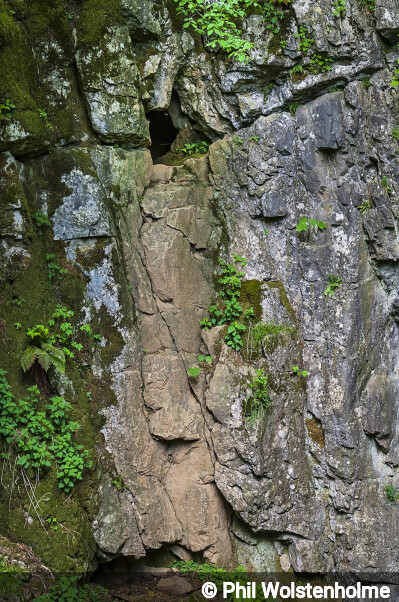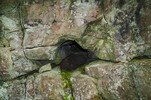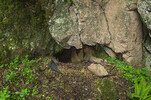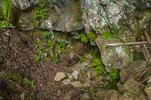Access
build Derbyshire Key required.
There is no parking near the cattle grid next to the cave because this area is used as a tractor turning-space - please park on the grass verge lower down the road (attached map shows the location) taking care to not block the road - it is not a simple track, and access is always required for normal road traffic and large farm vehicles. In wet weather the verges become very boggy and there is a risk of getting stuck. The farmer at the top of the hill 100m beyond the cattle grid is happy for a few cars to be parked on the grass at the end of his track. They ask that a note to say you are cavers is left on the dash of your car and advise that there is usually cattle in that field and you park at your own risk.
Two adjustable spanners are needed for the gate in the upper entrance. Access to the gate requires a bolt climb up the rock face. 13 closely spaced DCA resin anchors lead up to the entrance tunnel, with 2 more inside for a safety line. A further 2 anchors sit above the entrance to allow the rigging of an SRT pitch or for a pull-through at the end of the trip. The climb can be safely completed in a number of ways while keeping connections to at least 2 different anchors at all times. It is anticipated that someone in the visiting party will climb up first, and then rig for SRT or ladder/lifeline for the rest of the group. Some suggestions for possible climbing methods are as follows:
- Use dynamic cowstails and a footloop on a 3rd cowstail. Protect yourself with cowstails on 2 different anchors. Use your footloop clipped directly to an anchor to gain height, and move your cowstails higher. Hang on your short cowstail to allow you to move the footloop to a higher anchor each time. Remain under your attachment point and do not climb above where you clip your cowstails to.
- Use both ends of a 20m rope to ascend. Reach up and clip one end of the rope to an anchor, then SRT up this until you reach the knot. Connect the other end of the SRT rope to a higher anchor and transfer across from the original rope, before ascending up to the knot. Keep repeating the alternating swapping of rope ends until you reach the tunnel. Throughout the climb, use your cowstails to clip to other anchors so that you are never reliant on just the SRT rope on a single anchor. There are sufficient anchors to allow you to remain attached to 2 anchors at all times, even when moving jammers across from one rope to another.
- Use normal sport lead climbing techniques with dynamic rope and quickdraws.
On exit, a pull-though can be rigged using 2 anchors above the entrance so long as you have a rope no shorter than 20m. You should not rely on a single anchor at any point. A large number of bolts were placed to make this climb as safe as possible, but it relies on you climbing safely using appropriate equipment and techniques. Do not undertake the bolt climb unless you know what you are doing and understand the risks your chosen technique presents. You should bear in mind that even small falls onto caving rope or even dynamic cowstails can generate damaging impact forces on the human body, so it is safer to ascend whilst clipped into anchors above you, rather than risking a fall by climbing above your attachment points or cowstalis. It is not recommended to abseil in from above the cliff, owing to thick vegetation and plentiful loose rock.
Warning
20/12/2023 - The "Owls Bottom Entrance" shaft which is right in the base of the shakehole has collapsed. The scaffolding has moved under the weight of the boulders closing the shaft and way on. The collapse is approximately 10 metres down, where the knotted handline starts. Looking at the state of the dig shoring, some of the materials used have reached their life expectancy. The remaining timber that is holding parts of the spoil back is in a very poor state. The choke seems to take quite a bit of water and this has most probably aided the slumping in of the dig.
There is a significantly sized hollow sounding flake of rock on the cliff a few metres above the Owls Bottom Entrance shaft. This cannot be removed safely from below, so any future digging team may wish to bring this down from above before commencing any work in the Bottom Entrance.








